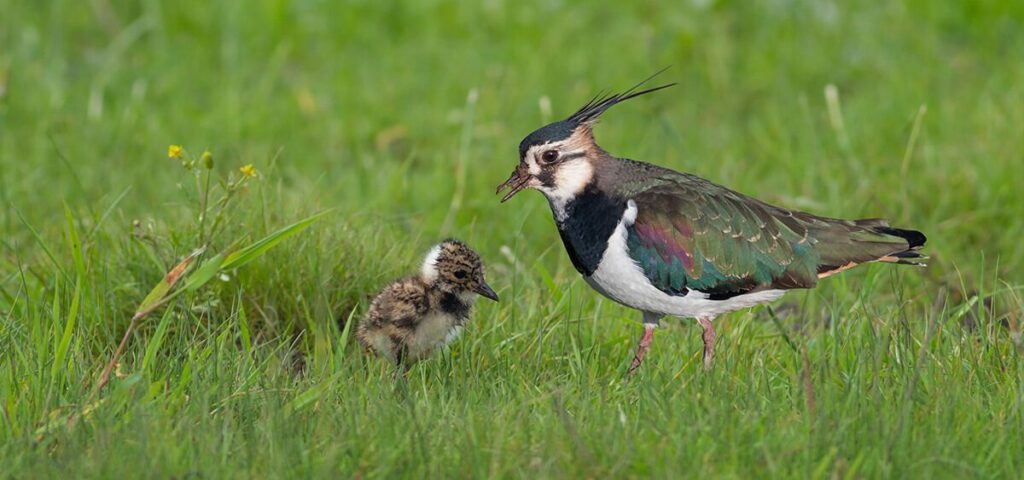In spring 2019, Oakbank was able to offer site-specific bird surveys to clients for the first time. Kirsty Brannan outlines how a fresh look at farmland birds can benefit you.
THE POWER OF DATA
From the sparrows chirping in the hedge in the morning, to the tawny owls calling after dark, most of us are surrounded by birds. They are part of our everyday lives, so it’s easy to take them for granted. But, birds can be useful indicators of the health of our environment. They rely on plentiful supplies of safe, natural food – in the form of insects, berries or seeds – and cover, to protect them from predators and harsh weather. Some specialist species are particularly sensitive to their surroundings; probing waders such as Woodcock and Snipe are nature’s soil health indicators, and Dippers can only thrive where water quality is high.
For anyone wanting to help wildlife, knowing which species are already present is an essential early step when identifying which activities are likely to be most important and effective. For example, last year I recorded Turtle Doves in thick scrub around a farm pond. After being made aware of them, the farmer re-arranged the planned pond restoration work so that there would always be some nesting cover available.
Evidence about your birds can have financial benefits too. For some Stewardship options, records of particular bird species are needed to unlock higher paying or appropriate options. Examples include GS9 Management of wet grassland for breeding waders, and SP9 Threatened species supplement for Corn Bunting.
Monitoring of bird numbers can also provide you with robust evidence of the impacts of your land management. This can be particularly helpful to think about before starting a new project. If you’re thinking of creating some new habitat for wildlife, or changing existing management, it’s important to be able to assess the difference this is making and clearly show its benefits. Bird surveys before and after can be a key part of that demonstration.
PROFESSIONAL SUPPORT
Many farmers and estate workers will already have a very good idea of which birds are around, and where. Similarly, you may be fortunate enough to have a friendly neighbourhood bird-watcher. However, often it is not enough to simply have a list of the species that have been seen. You need to be able to identify which are resident and which are visiting; which are dependent on your land and which are simply flying over it. More importantly, to show change over time you need a survey method that is carefully designed, repeatable and includes a sound analysis of the data recorded.
IN THE FIELD
This year, we are offering two bird survey packages suitable for most lowland areas. For sites where you simply want to know what species are present, package 1 consists of a single survey visit in May. For sites where you want to be able to measure the changes in birds over time, package 2 consists of two survey visits between April and early June.
In both cases, fieldwork begins at dawn. The site is walked so that all parts of it are covered; every bird seen or heard is identified and mapped, and any key behaviour recorded. Sites that are larger than 275 hectares are split across two mornings to minimise the risk of under-recording, as birds become less active later in the day.
Package 2 requires two visits to enable farm-level territory analysis. This involves mapping all the observations of a particular species from both visits on a single map, and then calculating the number of likely breeding territories using standardised rules. For example, a single observation of a bird may not indicate a breeding territory unless it’s of a male singing, an adult carrying nesting material or chick food, or is close to another observation made at least ten days apart. The reported number of territories is the minimum required to accommodate the observations made. This extra step is important in ensuring the information about bird abundance is scientifically robust, clearly understood and repeatable in the future.
Other surveys are available for more specialist areas such as moorland, woodland and lowland wet grassland.
RESULTS THAT COUNT
The results of each bird survey are bespoke to your farm, and typical outputs are described in the table below.
PACKAGE 1
PACKAGE 2
Full species list
✓
✓
Number of individuals birds recorded
✓
✓
Number of breeding territories present (usually red / amber-listed species only)
✓
Digital map showing red / amber-listed species
Individual sightings
Breeding territories
Number of birds per area (by conservation status)
✓
✓
Bird mass present (by conservation status)
✓
✓
As well as returning your farm-specific results, at the end of the season I also compile a short report showing all the results for the year. Each site within it is anonymised, but it provides enough context to see how your results compare with other sites.
FINDING OUT MORE
This year, a limited number of bird surveys is available on a first-come, first-served basis and bookings are being taken now. To discuss your requirements, get in touch directly with Kirsty on 07379 285818 or by emailing kirsty@smv.yvf.mybluehost.me.

